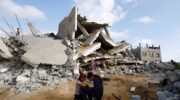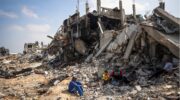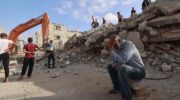Raed Radayda and Fatima Taqatqa, both 15 years old, were killed by Israeli soldiers.
The Palestinian Center for Human Rights documents crimes committed in the occupied Palestinian territories in weekly reports. We summarize their reports and stories from other news agencies with the goal of informing Americans of the ongoing violence that Palestinian families face each day under Israel’s occupation of their ancestral lands. The Israeli government receives $3 billion per year in direct military aid from U.S. taxpayers.
May 18, 2017 – May 24, 2017
West Bank
- The Israeli military continued its 50-year long military occupation of Palestinian land in the West Bank, under which the 2.8 million Palestinians living there are subjected to a different set of laws and treatment than Jewish settlers (numbering 588,000) are.
- Israeli soldiers shot and killed 15-year-old Raed Radayda near Bethlehem after he reportedly tried to stab soldiers at a checkpoint where Israelis control Palestinian travel between the northern and southern West Bank. Palestinian Red Crescent medics were prevented from attending to Raed, and he bled to death. The Israeli military did not report any injuries. There were no eyewitnesses to the alleged stabbing attack as Palestinians were on strike that day to support the mass hunger strike.
- After being shot in the head by Israeli soldiers in March, Fatima Taqatqa, 15, finally passed away in a Jerusalem hospital. She was shot after she lost control of her car and struck a median at the junction near the illegal Israeli settlement of Gush Etzion. The soldiers shot her after her vehicle had already come to a complete halt.
- Hundreds of Palestinian political prisoners in Israeli jails continued their hunger strike, which reached the 38 day mark on May 24. Many are suffering life-threatening conditions, including weight loss, weakness, difficulty speaking, standing & walking, high-blood pressure, kidney & chest pain, and vomiting of blood. Some have lost consciousness and have been transported to hospitals for immediate care.
- The Israeli Prison Service inflicted various forms of punishment on Palestinian prisoners on hunger strike, including:
- Subjecting them to dehumanizing strip searches
- Confiscating salt supplements and forcing them to drink unsanitary tap water
- Placing them in solitary confinement
- Providing insufficient medical examinations
- Transferring them from prison to prison
- Banning them from shaving their beards, cutting their nails, and washing their clothes
- Israeli forces attacked demonstrations in support of the Palestinian hunger strikers and hit an ambulance and a journalists’ cars with teargas canisters. At least 46 Palestinians, 12 of whom were children, sustained injuries.
- Israeli forces attacked the weekly demonstrations against Israeli’s Separation Wall in Bil’in and Nil’in villages, dispersing the protesters with tear gas, and injured 5 people, 2 of them children, with live bullets. They also arrested a child.
- Israeli forces carried out 48 invasions of Palestinian communities, raiding and searching homes, and arrested 94 civilians, 32 of them children.
- Jewish settlers set fire to a Palestinian man’s tractor and tagged his shops with Hebrew graffiti slogans.
- Hundreds of Jewish settlers stormed the Al-Aqsa Mosque yards and Israeli soldiers attacked the mosque’s guards.
- A group of Jewish settlers attempted to cut off the power supply and raid houses in a Palestinian village. Israeli occupying soldiers protected the settlers after Palestinians confronted them.
- A group of settlers caused a disturbance in a Palestinian village until midnight, obstructing travel for the Palestinians who lived there.
- Israeli forces erected dozens of temporary checkpoints, restricting movement for even more Palestinians, and arrested two adults and six Palestinian children at them. (There are 27 permanent checkpoints and hundreds of physical roadblocks placed by Israeli forces. Palestinians are prohibited from using 41 roads totaling 700 kilometers in the West Bank; only Israelis can travel on them.)
Gaza Strip
- Israel continued its 10-year illegal land, sea, and air blockade of the Gaza Strip, strictly controlling the movement of all 2 million Palestinians living there.
- Israeli navy forces opened fire at fishing boats off the coast of the Gaza Strip most days.
- Israeli forces continued to prevent most Gazans from entering or exiting the Strip (via the Israeli-controlled Erez crossing).
- Israeli forces opened fire on Palestinian agricultural lands near the border.
- Israeli forces continued to prevent most exports from Gaza, allowing only some produce items, fish and furniture. There is just one Israeli-controlled crossing (Kerem Shalom) for the movement of goods. Israel’s strict limits continue to severely cripple Gaza’s economy. Israeli officials told the U.S. that their goal is to keep Gaza “on the brink of collapse” and “‘functioning at the lowest level possible consistent with avoiding a humanitarian crisis.”
Read the full PCHR report, which also contains daily summaries. The UN Office for the Coordination of Humanitarian Affairs (UN-OCHA) also publishes a “Protection of Civilians” report on the occupied Palestinian territories every two weeks. Their latest report covers May 2 to May 15.





